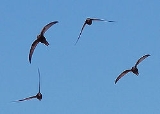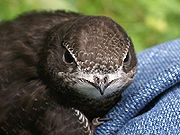
Common Swift
Encyclopedia
The Common Swift is a small bird
, superficially similar to the Barn Swallow
or House Martin
. It is, however, completely unrelated to those passerine
species, since swift
s are in the separate order Apodiformes
. The resemblances between the groups are due to convergent evolution
reflecting similar life styles.
The scientific name comes from the Ancient Greek
ἄπους, apous, meaning "without feet". These birds have very short legs which they use only for clinging to vertical surfaces (hence the German name Mauersegler, literally meaning "wall-glider"). They never settle voluntarily on the ground.
in 1758. The scientific name comes from the Ancient Greek
words α "without", and πούς, "feet". The predecessor of the Central European subspecies
which lived during the last ice age has been described as Apus apus palapus.
.
The call is a loud scream in two different tone pitches, of which the higher one is from the female and the lower one from the male. They often form 'screaming parties' during summer evenings where about 10-15 gather and fly around in circles, all calling out to each other.
, and in midsummer they are found in Great Britain
and northern Europe
, while they winter much further south in southern Africa
.
 Swifts will occasionally live in forest
Swifts will occasionally live in forest
s, but they have adapted more commonly to human
sites and will build their nest
s in all suitable hollows in buildings, under window sills, in the corner rafters of wooden buildings, in chimneys, and in smokestacks. A swift will return to the same nesting site year after year, rebuilding its nest when necessary.
Young swifts in the nest can drop their body temperature and become torpid if bad weather prevents their parents from catching insects nearby.
 Swifts spend most of their lives in the air, living on the insects they catch in their beaks. They drink, feed, and often mate and sleep on the wing.
Swifts spend most of their lives in the air, living on the insects they catch in their beaks. They drink, feed, and often mate and sleep on the wing.
.
bird known as the "martlet
", which is represented without feet, may have been based on the swift, but is generally assumed to refer to the house martin; it was used for the arms of younger sons, perhaps because it symbolized their landless wandering.
Database entry includes justification for why this species is of least concern
Bird
Birds are feathered, winged, bipedal, endothermic , egg-laying, vertebrate animals. Around 10,000 living species and 188 families makes them the most speciose class of tetrapod vertebrates. They inhabit ecosystems across the globe, from the Arctic to the Antarctic. Extant birds range in size from...
, superficially similar to the Barn Swallow
Barn Swallow
The Barn Swallow is the most widespread species of swallow in the world. It is a distinctive passerine bird with blue upperparts, a long, deeply forked tail and curved, pointed wings. It is found in Europe, Asia, Africa and the Americas...
or House Martin
House Martin
The Common House Martin , sometimes called the Northern House Martin or, particularly in Europe, just House Martin, is a migratory passerine bird of the swallow family which breeds in Europe, north Africa and temperate Asia; and winters in sub-Saharan Africa and tropical Asia...
. It is, however, completely unrelated to those passerine
Passerine
A passerine is a bird of the order Passeriformes, which includes more than half of all bird species. Sometimes known as perching birds or, less accurately, as songbirds, the passerines form one of the most diverse terrestrial vertebrate orders: with over 5,000 identified species, it has roughly...
species, since swift
Swift
The swifts are a family, Apodidae, of highly aerial birds. They are superficially similar to swallows, but are actually not closely related to passerine species at all; swifts are in the separate order Apodiformes, which they share with hummingbirds...
s are in the separate order Apodiformes
Apodiformes
Traditionally, the bird order Apodiformes contained three living families: the swifts , the tree swifts , and the hummingbirds . In the Sibley-Ahlquist taxonomy, this order is raised to a superorder Apodimorphae in which hummingbirds are separated as a new order, Trochiliformes...
. The resemblances between the groups are due to convergent evolution
Convergent evolution
Convergent evolution describes the acquisition of the same biological trait in unrelated lineages.The wing is a classic example of convergent evolution in action. Although their last common ancestor did not have wings, both birds and bats do, and are capable of powered flight. The wings are...
reflecting similar life styles.
The scientific name comes from the Ancient Greek
Ancient Greek
Ancient Greek is the stage of the Greek language in the periods spanning the times c. 9th–6th centuries BC, , c. 5th–4th centuries BC , and the c. 3rd century BC – 6th century AD of ancient Greece and the ancient world; being predated in the 2nd millennium BC by Mycenaean Greek...
ἄπους, apous, meaning "without feet". These birds have very short legs which they use only for clinging to vertical surfaces (hence the German name Mauersegler, literally meaning "wall-glider"). They never settle voluntarily on the ground.
Taxonomy
The Common Swift was one of the many species described by Linnaeus in his Systema naturaeSystema Naturae
The book was one of the major works of the Swedish botanist, zoologist and physician Carolus Linnaeus. The first edition was published in 1735...
in 1758. The scientific name comes from the Ancient Greek
Ancient Greek
Ancient Greek is the stage of the Greek language in the periods spanning the times c. 9th–6th centuries BC, , c. 5th–4th centuries BC , and the c. 3rd century BC – 6th century AD of ancient Greece and the ancient world; being predated in the 2nd millennium BC by Mycenaean Greek...
words α "without", and πούς, "feet". The predecessor of the Central European subspecies
Subspecies
Subspecies in biological classification, is either a taxonomic rank subordinate to species, ora taxonomic unit in that rank . A subspecies cannot be recognized in isolation: a species will either be recognized as having no subspecies at all or two or more, never just one...
which lived during the last ice age has been described as Apus apus palapus.
Description
Common Swifts are 16–17 cm long with a wingspan of 38–40 cm and entirely blackish-brown except for a small white or pale grey patch on their chins which is not visible from a distance. They have a short forked tail and very long swept-back wings that resemble a crescent or a boomerangBoomerang
A boomerang is a flying tool with a curved shape used as a weapon or for sport.-Description:A boomerang is usually thought of as a wooden device, although historically boomerang-like devices have also been made from bones. Modern boomerangs used for sport are often made from carbon fibre-reinforced...
.
The call is a loud scream in two different tone pitches, of which the higher one is from the female and the lower one from the male. They often form 'screaming parties' during summer evenings where about 10-15 gather and fly around in circles, all calling out to each other.
Migration
Like swallows, Common Swifts are migratoryBird migration
Bird migration is the regular seasonal journey undertaken by many species of birds. Bird movements include those made in response to changes in food availability, habitat or weather. Sometimes, journeys are not termed "true migration" because they are irregular or in only one direction...
, and in midsummer they are found in Great Britain
Great Britain
Great Britain or Britain is an island situated to the northwest of Continental Europe. It is the ninth largest island in the world, and the largest European island, as well as the largest of the British Isles...
and northern Europe
Europe
Europe is, by convention, one of the world's seven continents. Comprising the westernmost peninsula of Eurasia, Europe is generally 'divided' from Asia to its east by the watershed divides of the Ural and Caucasus Mountains, the Ural River, the Caspian and Black Seas, and the waterways connecting...
, while they winter much further south in southern Africa
Africa
Africa is the world's second largest and second most populous continent, after Asia. At about 30.2 million km² including adjacent islands, it covers 6% of the Earth's total surface area and 20.4% of the total land area...
.
Breeding

Forest
A forest, also referred to as a wood or the woods, is an area with a high density of trees. As with cities, depending where you are in the world, what is considered a forest may vary significantly in size and have various classification according to how and what of the forest is composed...
s, but they have adapted more commonly to human
Human
Humans are the only living species in the Homo genus...
sites and will build their nest
Bird nest
A bird nest is the spot in which a bird lays and incubates its eggs and raises its young. Although the term popularly refers to a specific structure made by the bird itself—such as the grassy cup nest of the American Robin or Eurasian Blackbird, or the elaborately woven hanging nest of the...
s in all suitable hollows in buildings, under window sills, in the corner rafters of wooden buildings, in chimneys, and in smokestacks. A swift will return to the same nesting site year after year, rebuilding its nest when necessary.
Young swifts in the nest can drop their body temperature and become torpid if bad weather prevents their parents from catching insects nearby.
Feeding

Parasites
Swift nests commonly support populations of the Chewing Louse, Dennyus hirundinis and the Lousefly, Crataerina pallidaCrataerina pallida
Crataerina pallida, the swift lousefly, is a species of biting fly in the family of louse flies Hippoboscidae. These flies are commonly encountered in the nests of the Common Swift in Europe and Asia....
.
In heraldry
The heraldicHeraldry
Heraldry is the profession, study, or art of creating, granting, and blazoning arms and ruling on questions of rank or protocol, as exercised by an officer of arms. Heraldry comes from Anglo-Norman herald, from the Germanic compound harja-waldaz, "army commander"...
bird known as the "martlet
Martlet
A martlet is a heraldic charge depicting a stylized bird with short tufts of feathers in the place of legs...
", which is represented without feet, may have been based on the swift, but is generally assumed to refer to the house martin; it was used for the arms of younger sons, perhaps because it symbolized their landless wandering.
External links
- The Common Swift website
- APUSlife The Virtual Magazine of the Common Swift
- Birds of Britain: The Swift
- Live webcam pictures from a common swift nest
- Diet & Hand rearing
- London's Swifts Homepage
- Ageing and sexing (PDF) by Javier Blasco-Zumeta
Database entry includes justification for why this species is of least concern

